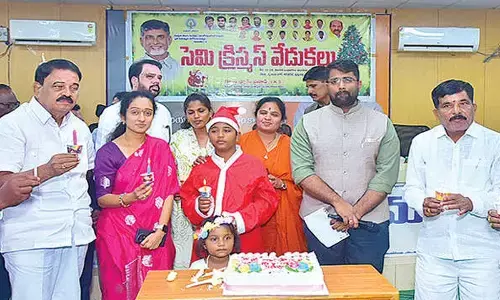Act more and in right earnest

The present farm crisis and the resultant agitations should have been anticipated by the Centre and appropriate measures should have been put in place to tackle the unrest among farmers, if any. Whatever may be the claims of politicians, one cannot rule out laxity on part of the government in handling the issue.
The present farm crisis and the resultant agitations should have been anticipated by the Centre and appropriate measures should have been put in place to tackle the unrest among farmers, if any. Whatever may be the claims of politicians, one cannot rule out laxity on part of the government in handling the issue.
The ongoing agitations in Madhya Pradesh, Maharashtra, Rajasthan and Karnataka only have the potential to grow into a huge headache for the BJP-led NDA government in future as those also give the Opposition a room to dabble and muddy the waters further.
There are several issues involved in it and several committees have studied the problem at length and listed their solutions. The most profound of all were the recommendations of the National Commission of Farmers under the chairmanship of Dr M S Swaminathan.
The committee report is taken as the most pragmatic because its definition of farmers included agricultural labour, sharecroppers, tenants, small, marginal and sub-marginal farmers, farmers with larger holdings, fishermen and women, dairy, sheep, poultry and other farmers involved in animal husbandry as well as those engaged in sericulture, vermiculture, production of bio-fertilisers and bio-pesticides and agro-processing etc. The Commission also took into consideration tribal folk who were into shift-cultivation and those dependent on non-timber forest produce income.
The emphasis of the Commission was on Cost Risk Structure Agricultural Renewal Action Plan, Soil Health Enhancement, Irrigation Water Supply Augmentation and Demand Management Credit and Insurance Technology Marketing.
Here is the main concern, however: Farmers in India frequently faced fury of the nature in the form of drought, unseasonal and heavy rains causing extensive damage to crops. In addition, a weak institutional support and increasing cost of production and low minimum support prices (MSP) had led to an adverse cost risk structure of farming. This had led to indebtedness and great distress.
The committee also pointed out that inputs that were helpful during the green revolution period had been giving fewer returns since 1980s' and the capital formation in agriculture and allied sectors as a percentage of gross domestic product (GDP) had declined for a long term.
An unfriendly rural infrastructure only aided and abetted the farmer suicides in large numbers in the country. Another important aspect that one should keep in mind is the nature of land holdings in the country. This is really key to the problems abounding now and which no government has either really studied or cared to look into and tackle.
The present agrarian crisis is the result of short-sighted policies implemented by successive governments over several decades. Loan waiver alone is neither a solution to the crisis nor would it prevent farmer suicides in the country in future. This temporary measure would only burden the economy further and, as banks have been warning, would lead to a greater economic crisis in the long run.
Farmers in several parts of India have been protesting for higher prices for agricultural produce and loan waivers. The protests in Madhya Pradesh turned violent and six persons had been killed in police firing. The media was awash with pictures of farmers (or even political activists as the case may be which does not diminish the tragedy a bit anyway) emptying milk vans and dumping vegetables on the roads. The protests may temporarily ease but with each picking season, those are only going to increase.
A major cause of farm crisis has its roots in the size of farms. As families grow with the land remaining the same, the nature of holdings gets changed when the property is shared among the younger members of the family.
A National Sample Survey study indicates that while the number of land holdings during 1970-71 was around 70 millions across 160 million hectares of land, 49 million of these farms were small and marginal farms operating on land up to two hectares.
By 2010-11 the number of farms holdings doubled to 138 million and the small and marginal holdings increased to 117 millions. The study further discloses that by 2040 the land holdings will be 186 million with the small and marginal holdings increasing to 166 million.
This means that a relatively low land-man ratio, unequal distribution of land ownership, a high degree of subdivision and fragmentation of holdings, predominance of small farms operated mostly by owner cultivators, the limited role of tenancy and high dependence on wage labour for agricultural operations are the distinguishing characteristics of the Indian agrarian economy.
The broad, highly skewed nature of size distribution of ownership holdings has, by and large, remained unchanged over a period of four decades, notwithstanding the progressively downward shift in the distribution.
Hence, small farmers are finding it difficult to sustain themselves on agriculture. Maintaining farm equipment and irrigation systems and even bullocks has become cost-ineffective for the small time farmers. Moreover, the inputs like power supply and bank loans also only multiply his crisis.
Both Madhya Pradesh and Maharashtra which are witnessing farm unrest now have a large area under rainfed conditions. Despite drought of a few years, this year they reaped a bumper crop but they are not happy with the procurement price being unable to repay loans taken, both from banking institutions and private moneylenders. A farmer, small farmer more so, is dependent on these loans invariably and looks towards his kharif crop loan.
Hence they seek a loan waiver too apart from remunerative prices. Here is the catch. If banks keep lending money and waiving them at the instance of the governments, then these will have lesser and lesser money for strengthening the very agricultural infrastructure and research that go into seed production, soil health enhancement and plant protection etc.
As Dr Swaminathan himself observed recently in an interview to Al Jajeera, in rainfed areas, water security depends on rainwater harvesting and the efficient use of the available water through techniques like drip irrigation and the appropriate choice of farming systems. Groundwater augmentation and management is an important method of ensuring adequate and timely availability of water for crops.
No doubt, the Modi government has implemented several recommendations of the Commission such as providing improved seeds, soil health cards, agricultural credit reform, improved insurance, increasing the area under irrigation and the addition of farmers welfare to the responsibility of the Ministry of Agriculture, but more needs to be done in tackling the problem of smaller holdings.
The Commission had also recommended a major non-farm initiative, on the model of rural township programme of China which would involve agriculture-based enterprises such as mushroom cultivation, use of bio-pesticides and bio-pesticides and fertilisers, apiculture, inland and coastal aquaculture and the biological software essential for sustainable agriculture, which is the second goal of the Sustainable Development Goals.
The panel also emphasised that credit reform is the primary pathway to enhancing small farm productivity and ending farmer suicides. In this direction, it suggested to reduce interest rates on crops to 4%.
Natural calamities such as droughts and floods lead the farmers to default on their loans. To meet the natural calamities, the union and the state governments should come forward to create an “Agriculture Risk Fund” to provide relief to drought and flood-hit farmers.
Another flaw the committee noted was that the performance of the new varieties of seeds should be judged on the basis of “net income per hectare” and not just in terms of yield per hectare. The governments should add post-harvest technology wing to the Krishi Vigyan Kendras. Government should add lab-to-land demonstrations in dry farming areas where millets, pulses, oilseeds and cotton are grown.
Success in agricultural progress should be measured by growth rate in farmers’ income and not just by production figures. The gap between what the rural producer gets and the urban consumer pays should be made as narrow as possible, as has been done in the case of milk by Dr V Kurien.
At the same time, there should be a Risk Stabilisation Fund and a farmer-centric MSP and Market Intervention Scheme (MIS). The last one is crucial to ensure minimum profitability to the farmer. Why should a farmer who pays the maximum for inputs get only a minimum support price?
All this should not be a big deal for the Modi-led BJP government if it takes agriculture seriously enough. After all, it has several support systems outside the government too to propagate its policies and programmes. Wish it does so in right ernest!

















